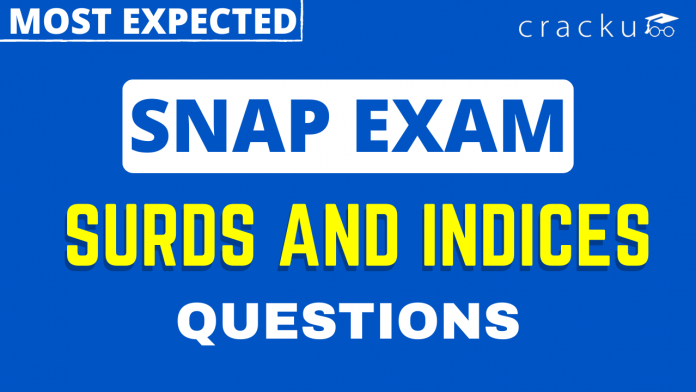SNAP Surds and Indices Questions PDF [Most Important]
The Surds and Indices is an important topic in the Quant section of the SNAP Exam. Quant is a scoring section in SNAP, so it is advised to practice as much as questions from quant. This article provides some of the most important Surds and Indices Questions for SNAP. One can also download this Free Surds and Indices Questions for SNAP PDF with detailed answers by Cracku. These questions will help you practice and solve the Surds and Indices questions in the SNAP exam. Utilize this PDF practice set, which is one of the best sources for practising.
Download Surds and Indices Questions for SNAP
Enroll to SNAP 2022 Crash Course
Question 1: If $(\sqrt{\frac{7}{5}})^{3x-y}=\frac{875}{2401}$ and $(\frac{4a}{b})^{6x-y}=(\frac{2a}{b})^{y-6x}$, for all non-zero real values of a and b, then the value of $x+y$ is
1) Answer: 14
Solution:
$(\sqrt{\frac{7}{5}})^{3x-y}=\frac{875}{2401}$
$\left(\frac{7}{5}\right)^{\frac{\left(3x-y\right)}{2}}=\frac{125}{343}$
$\left(\frac{7}{5}\right)^{\frac{\left(3x-y\right)}{2}}=\left(\frac{7}{5}\right)^{-3}$
3x-y = -6
$(\frac{4a}{b})^{6x-y}=(\frac{2a}{b})^{y-6x}$
Therefor, y=6x as the bases are different so the power should be zero for the results to be equal.
3x-y=-6
or, 3x – 6x = -6
or x= 2
y= 6x = 12
x+y = 14
Question 2: Find the value of $\sqrt{552+\sqrt{552+}\sqrt{552+…}}$
a) 26
b) -24
c) 24
d) -26
2) Answer (C)
Solution:
x = $\sqrt{552+\sqrt{552+}\sqrt{552+…}}$
$x^2-552$ = $\sqrt{552+\sqrt{552+}\sqrt{552+…}}$
$x^2 – x – 552 = 0$
(x-24)(x+23) = 0
x cannot be negative. Therefore, $\sqrt{552+\sqrt{552+}\sqrt{552+…}}$ = 24
Answer is option C.
Question 3: If $x=(4096)^{7+4\sqrt{3}}$, then which of the following equals to 64?
a) $\frac{x^{7}}{x^{2\sqrt{3}}}$
b) $\frac{x^{\frac{7}{2}}}{x^{\frac{4}{\sqrt{3}}}}$
c) $\frac{x^{\frac{7}{2}}}{x^{2{\sqrt{3}}}}$
d) $\frac{x^{7}}{x^{4\sqrt{3}}}$
3) Answer (C)
Solution:
$x=2^{12\left(7+4\sqrt{\ 3}\right)}$.
$x^{\frac{7}{2}}=2^{42\left(7+4\sqrt{\ 3}\right)}$
$x^{2\sqrt{\ 3}}=2^{24\sqrt{\ 3}\left(7+4\sqrt{\ 3}\right)}$
$\frac{x^{\frac{7}{2}}}{x^{2{\sqrt{3}}}}$ = $2^{\left(7+4\sqrt{\ 3}\right)\left(42-24\sqrt{\ 3}\right)}=2^{\left(7+4\sqrt{\ 3}\right)\left(7-4\sqrt{\ 3}\right)6}$ =$2^6$.
Hence C is correct answer.
Question 4: The value is?
$5^{\frac{1}{4}} \times (125)^{0.25}$
a) 5
b) 25
c) 50
d) 10
4) Answer (A)
Solution:
$5^{\frac{1}{4}}$ * $125^{0.25}$
= $5^{0.25}$ * $5^{3*0.25}$
= $5^{0.25+0.75}$
=$5^1$
=5
Question 5: If m and n are integers such that $(\surd2)^{19} 3^4 4^2 9^m 8^n = 3^n 16^m (\sqrt[4]{64})$ then m is
a) -20
b) -24
c) -12
d) -16
5) Answer (C)
Solution:
We have, $(\surd2)^{19} 3^4 4^2 9^m 8^n = 3^n 16^m (\sqrt[4]{64})$
Converting both sides in powers of 2 and 3, we get
$2^{\ \frac{19\ }{2}}3^42^43^{2m}2^{3n}$ = $3^n2^{4m}2^{\frac{\ 6}{4}}$
Comparing the power of 2 we get, $\ \frac{\ 19}{2}+4+3n\ =4m+\frac{\ 6}{4}\ $
=> 4m=3n+12 …..(1)
Comparing the power of 3 we get, $4+2m=n$
Substituting the value of n in (1), we get
4m=3(4+2m)+12
=> m=-12
Take SNAP mock tests here
Enrol to 10 SNAP Latest Mocks For Just Rs. 499
Question 6: If $(5.55)^x = (0.555)^y = 1000$, then the value of $\frac{1}{x} – \frac{1}{y}$ is
a) $\frac{1}{3}$
b) 3
c) 1
d) $\frac{2}{3}$
6) Answer (A)
Solution:
We have, $(5.55)^x = (0.555)^y = 1000$
Taking log in base 10 on both sides,
x($\log_{10}555$-2) = y($\log_{10}555$-3) = 3
Then, x($\log_{10}555$-2) = 3…..(1)
y($\log_{10}555$-3) = 3 …..(2)
From (1) and (2)
=> $\log_{10}555$=$\ \frac{\ 3}{x}$+2=$\ \frac{\ 3}{y}+3$
=> $\frac{1}{x} – \frac{1}{y}$ = $\frac{1}{3}$
Question 7: If $R_c = mln \left(1 + \frac{R_m}{m}\right)$ then $R_m$ is equal to
a) $R_m = ln\left(1 + \frac{R_c}{m}\right)$
b) $R_m = ln\left(1 + \frac{R_c}{e}\right)$
c) $R_m = m\left(e^{\frac{R_c}{m}} – 1 \right)$
d) Cannot be determined
7) Answer (C)
Solution:
$R_c = mln \left(1 + \frac{R_m}{m}\right)$
$\ \frac{\ R_c}{m}$ = $ln \left(1 + \frac{R_m}{m}\right)$
$\ \frac{\ R_m}{m}+\ 1\ =\ e^{\ \frac{\ R_c}{m}}$
$\ \frac{\ R_m}{m}\ =\ e^{\ \frac{\ R_c}{m}-1}$
$R_m = m\left(e^{\frac{R_c}{m}} – 1 \right)$
C is the correct answer.
Question 8: $\left\{\frac{2^{\frac{1}{2}} \times 3^{\frac{1}{3}} \times 4^{\frac{1}{4}}}{10^{\frac{-1}{5}} \times 5^{\frac{3}{5}}} \div \frac{3^{\frac{4}{3}} \times 5^{\frac{-7}{5}}}{4^{\frac{-3}{5}} \times 6}\right\} \times 2 =$
a) 10
b) 20
c) 30
d) 40
8) Answer (B)
Solution:
we have :
$\frac{\left(2^{\frac{1}{2}}\times\ 3^{\frac{1}{3}}\times\ 4^{\frac{1}{4}}\right)}{10^{-\frac{1}{5}}\times\ 5^{\frac{3}{5}}}\ \ \ \ $
Now 4 = 2^2 and 10 = 2*5
We get $\ \frac{\left(2^{\frac{1}{2}+\frac{1}{2}}\times3^{\frac{1}{3}}\ \right)}{2^{-\frac{1}{5}}\times\ 5^{-\frac{1}{5}}\times\ 5^{\frac{3}{5}}}=\frac{\left(2^{\frac{6}{5}}\times\ 3^{\frac{1}{3}}\right)}{5^{\frac{2}{5}}}$ (1)
Now the next term we have is :$\frac{\left(3^{\frac{4}{3}}\times\ 5^{-\frac{7}{5}}\right)}{4^{-\frac{3}{5}}\times\ 6}$
6= 2*3 and 4=2^2
We get $\frac{\left(3^{\frac{1}{3}}\times\ 5^{-\frac{7}{5}}\right)}{2^{-\frac{1}{5}}}$ (2)
Dividing (1) and (2) we get
$\frac{\left(2^{\frac{6}{5}}\times\ 3^{\frac{1}{3}}\right)}{5^{\frac{2}{5}}}\times\ \frac{\left(2^{-\frac{1}{5}}\right)}{3^{\frac{1}{3}}\times\ 5^{-\frac{7}{5}}}$
= $\frac{2}{5^{-1}}=10$
Now we have to multiply by 2
so we get 10*2=20
Question 9: If $x=8-\sqrt{32}$ and $y=2+\sqrt{2}$, then $\left(x+\frac{1}{y}\right)^2$ is given by:
a) $\frac{16}{25}x^2$
b) $\frac{64}{81}y^2$
c) $\frac{25}{16}y^2$
d) $\frac{81}{64}x^2$
9) Answer (D)
Solution:
$x=8-\sqrt{32}$ and $y=2+\sqrt{2}$,
We have to find the value of $\left(x+\frac{1}{y}\right)^2$
$\left(8-\sqrt{\ 32}+\ \frac{\ 1}{2+\sqrt{\ 2}}\right)^2$
$(\ \frac{\ 8\left(2+\sqrt{\ 2}\right)-\sqrt{\ 32}\left(2+\sqrt{\ 2}\right)+\ \ 1}{2+\sqrt{\ 2}})^2$
$\left(\ \frac{\ 9}{2+\sqrt{\ 2}}\right)^2$
$\ \frac{\ 81}{6+2\sqrt{\ 2}}$
$\left(\ \frac{\ 1}{y}\right)^2=\ \left(\frac{\ 1}{2+\sqrt{\ 2}}\right)^2$ = $6+2\sqrt{\ 2}$
=$\left(\ \frac{\ 2-\sqrt{\ 2}}{2}\right)^{^2}$
=$\ \frac{\ 6-4\sqrt{2\ }}{4}$
=$\ \frac{\ 3-2\sqrt{2\ }}{2}$
$x^2=64+32-64\sqrt{\ 2}$
=$96-64\sqrt{\ 2}$
=32($3-2\sqrt{\ 2}$) = 32*$2y^2$
we get, $x^{2\ }=\ 64y^2$
$\ \frac{\ 81}{y^2}=\ \frac{\ 81}{64}x^2$
D is the correct answer.
Alternative solution,
$xy=\left(8-\sqrt{\ 32}\right)\left(2+\sqrt{\ 2}\right)=4\sqrt{\ 2}\left(\sqrt{\ 2}-1\right)\times\ \sqrt{\ 2}\left(\sqrt{\ 2}+1\right)=8\left(2-1\right)=8$
(As $xy=8\ \longrightarrow\ y=\dfrac{x}{8}$)
$\left(x+\frac{1}{y}\right)^2=\left(\frac{\left(xy+1\right)}{y}\right)^2=\left(\frac{\left(xy+1\right)\times\ x}{8}\right)^2=\left(\frac{\left(8+1\right)\times\ x}{8}\right)^2=\frac{81}{64}\times\ x^2$
Question 10: If $2^x + 2^{x + 1} = 48$, then the value of $x^x$ is
a) 4
b) 64
c) 256
d) 16
10) Answer (C)
Solution:
$2^x\ +\ 2^x.2\ =48$
$2^x\ \left(1+2\right)\ =48$
$2^x\ =16$
x=4
$4^4=256$
Question 11: Find the value of $\sqrt{\frac{2 + \sqrt3}{2 – \sqrt3}}$
Correct to three places of decimal.
a) 3.141
b) 2.732
c) 3.124
d) 3.732
11) Answer (D)
Solution:
Let us consider $\frac{2 + \sqrt3}{2 – \sqrt3}$
Rationalising the denominator by multiplying and diving with 2+$\sqrt3$ we get,
$\frac{(2 + \sqrt3)\times (2 + \sqrt3) }{(2 – \sqrt3)\times (2 + \sqrt3) } = \frac {(2 + \sqrt3)^2}{4 – 3} = (2 + \sqrt3)^2$
Now,
$\sqrt{\frac{2 + \sqrt3}{2 – \sqrt3}} = \sqrt{(2 + \sqrt3)^2} = 2 + \sqrt3 = 2 + 1.732 = 3.732$
Question 12: If a and b are positive real numbers and $a * b$ denotes $\sqrt{a \times b}$, what is the value of 8 * (4 * 16)?
a) $4^{1/3}$
b) 16
c) 8
d) $4\sqrt2$
12) Answer (C)
Solution:
Given, If a and b are positive real numbers then a * b denotes √ab
Consider 4 * 16 = $\sqrt{4\times 16} = \sqrt64 = 8$
then 8 * 8 = $\sqrt{8\times 8} = \sqrt64 = 8$
Hence the value of 8 * (4 * 16) = 8
Question 13: If x = $\sqrt[6]{5}$ and y = $\sqrt[5]{4}$, Which of the following is true?
a) x > y
b) y > x
c) x = y
d) None
13) Answer (B)
Solution:
Given x = $\sqrt[6]{5}$ and y = $\sqrt[5]{4}$
which can also be written as x = $5^{\frac{5}{30}}$ and y = $4^{\frac{6}{30}}$
which can be further written as x = $\sqrt[30]{5^5}$ and y = $\sqrt[30]{4^6}$
As we know $4^6 > 5^5$
$\Rightarrow \sqrt[30]{4^6} > \sqrt[30]{5^5} $
$\Rightarrow$ y > x
Question 14: If N and x are positive integers such that $N^{N}$ = $2^{160}\ and \ N{^2} + 2^{N}\ $ is an integral multiple of $\ 2^{x}$, then the largest possible x is
14) Answer: 10
Solution:
It is given that $N^{N}$ = $2^{160}$
We can rewrite the equation as $N^{N}$ = $(2^5)^{160/5}$ = $32^{32}$
$\Rightarrow$ N = 32
$N{^2} + 2^{N}$ = $32^2+2^{32}=2^{10}+2^{32}=2^{10}*(1+2^{22})$
Hence, we can say that $N{^2} + 2^{N}$ can be divided by $2^{10}$
Therefore, x$_{max}$ = 10
Question 15: Given that $x^{2018}y^{2017}=\frac{1}{2}$, and $x^{2016}y^{2019}=8$, then value of $x^{2}+y^{3}$ is
a) $\dfrac{31}{4}$
b) $\dfrac{35}{4}$
c) $\dfrac{37}{4}$
d) $\dfrac{33}{4}$
15) Answer (D)
Solution:
Given that $x^{2018}y^{2017}=\frac{1}{2}$ … (1)
$x^{2016}y^{2019}=8$ … (2)
Equation (2)/ Equation (1)
$\dfrac{y^2}{x^2} = \dfrac{8}{1/2}$
$\dfrac{y}{x} = 4$ or $-4$
Case 1: When $\dfrac{y}{x} = 4$
$x^{2018}(4x)^{2017}=\dfrac{1}{2}$
$x^{2018+2017}(2)^{4034}=\dfrac{1}{2}$
$x^{4035}=\dfrac{1}{(2)^{4035}}$
$x=\dfrac{1}{2}$
Since, $\dfrac{y}{x} = 4$, => y = 2
Therefore, $x^{2}+y^{3}$ = $\dfrac{1}{4}+8$ = $\dfrac{33}{4}$
Case 2: When $\dfrac{y}{x} = -4$
$x^{2018}(-4x)^{2017}=\dfrac{1}{2}$
$x^{2018+2017}(2)^{4034}=\dfrac{-1}{2}$
$x^{4035}=\dfrac{1}{(-2)^{4035}}$
$x=\dfrac{-1}{2}$
Since, $\dfrac{y}{x} = -4$, => y = 2
Therefore, $x^{2}+y^{3}$ = $\dfrac{1}{4}+8$ = $\dfrac{33}{4}$. Hence, option D is the correct answer.





